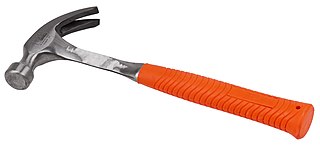 W
WA hammer is a tool consisting of a weighted "head" fixed to a long handle that is swung to deliver an impact to a small area of an object. This can be, for example, to drive nails into wood, to shape metal, or to crush rock. Hammers are used for a wide range of driving, shaping, and breaking applications.
 W
WA ball-peen or ball pein hammer, also known as a machinist's hammer, is a type of peening hammer used in metalworking. It has two heads, one flat and the other, called the peen, rounded. It is distinguished from a cross-peen hammer, diagonal-peen hammer, point-peen hammer, or chisel-peen hammer by having a hemispherical peen.
 W
WA bush hammer is a masonry tool used to texturize stone and concrete. Bush hammers exist in many forms, from simple hand-held hammers to large electric machines, but the basic functional property of the tool is always the same – a grid of conical or pyramidal points at the end of a large metal slug. The repeated impact of these points into stone or concrete creates a rough, pockmarked texture that resembles naturally weathered rock. They can help to increase bonding effectiveness when applying new concrete to an existing concrete surface by increasing the surface area of the bonding zone.
 W
WA claw hammer is a tool primarily used for driving nails into, or pulling nails from, some other object. Generally, a claw hammer is associated with woodworking but is not limited to use with wood products. It is not suitable for heavy hammering on metal surfaces, as the steel of its head is somewhat brittle; the ball-pein hammer is more suitable for such metalwork.
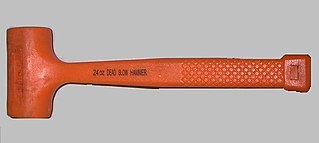 W
WA dead blow hammer is a specialized mallet helpful in minimizing damage to the struck surface and in controlling striking force, with minimal rebound from the struck surface. The minimal rebound is helpful in avoiding accidental damage to precision work, especially in tight locations and in applications such as maintenance work on hydraulic cylinders.
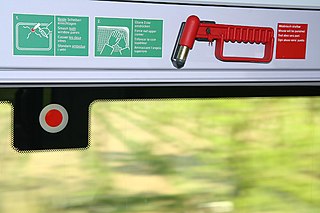 W
WAn emergency hammer is a safety device used in vehicles or buildings to break through window glass in an emergency. Emergency hammers are also known as bus mallets, dotty hammers, safety mallets, and bus hammers. Many are attached to a cable or an alarm device to deter theft or vandalism.
 W
WFraming hammers, used for framing wooden houses, are heavy duty rip hammers with a straight claw. The hammer heads typically weigh from 20 to 32 ounces for steel heads, and 12 to 16 ounces for titanium heads. Heavy heads, longer handles and milled faces allow for driving large nails quickly into dimensional lumber.
 W
WA froe, shake axe or paling knife is a tool for cleaving wood by splitting it along the grain. It is an L-shaped tool, used by hammering one edge of its blade into the end of a piece of wood in the direction of the grain, then twisting the blade in the wood by rotating the haft (handle).
 W
WA gavel is a small ceremonial mallet commonly made of hardwood, typically fashioned with a handle. It is used almost exclusively in the United States in legislatures and courts of law, but is used worldwide for auctions. It can be used to call for attention or to punctuate rulings and proclamations and is a symbol of the authority and right to act officially in the capacity of a presiding officer. It is often struck against a sound block, a striking surface typically also made of hardwood, to enhance its sounding qualities. According to tradition, Vice President John Adams used a gavel as a call to order in the first U.S. Senate in New York in the spring of 1789. Since then, it has remained customary to tap the gavel against a lectern or desk to indicate the opening and closing of proceedings, and it is also used to keep the meeting itself calm and orderly.
 W
WA geologist's hammer, rock hammer, rock pick, or geological pick is a hammer used for splitting and breaking rocks. In field geology, they are used to obtain a fresh surface of a rock to determine its composition, bedding orientation, nature, mineralogy, history, and field estimate of rock strength. In fossil and mineral collecting, they are employed to break rocks with the aim of revealing fossils inside. Geologist's hammers are also sometimes used for scale in a photograph. The hammer also serves as an extension of the senses, permitting the geologist to perceive the rock's granularity, soundness, and resistance to fracturing that may be relevant to its use or identification.
 W
WA glass breaker is a small hand tool designed to aid in the emergency extrication of occupants from a vehicle. Most glass breakers contain a sharp pointed metal tip for breaking tempered glass and a sharp knife for slicing through seatbelts. Glass breakers are also built into other tools, such as flashlights or multitools. Unlike bus mallets, glass breakers are smaller and generally privately owned. There are many variations of glass breakers on the market. One variation found in glass breakers is the material of which the metal tip is made from. Although all glass breakers are made of strong materials, some glass breakers make breaking glass easier than others, depending on the hardness of the metal that the tip is made of. Some sources have found that tungsten carbide tips make breaking glass less difficult. However, laminated glass cannot be broken by any glass breakers on the market. Glass breakers are only effective on tempered windows.
 W
WThe London Hammer is a name given to a hammer made of iron and wood that was found in London, Texas in 1936. Part of the hammer is embedded in a limey rock concretion, leading to it being regarded by some as an anomalous artifact, asking how a seemingly man-made tool could come to be encased in a 400 million year old rock.
 W
WA mallet is a kind of hammer, often made of rubber or sometimes wood, that is smaller than a maul or beetle, and usually has a relatively large head. The term is descriptive of the overall size and proportions of the tool, and not the materials it may be made of, though most mallets have striking faces that are softer than steel.
 W
WMjölnir is the hammer of Thor, the Norse god associated with thunder. Mjölnir is depicted in Norse mythology as one of the most fearsome and powerful weapons in existence. The Prose Edda relates that the hammer has a short handle due to a flaw in its manufacture.
 W
WMjolnir, known more formally as Mjölnir is a fictional magical weapon appearing in American comic books published by Marvel Comics. It is depicted as the principal weapon of the superhero Thor and Jane Foster. Mjolnir, which first appears in Journey into Mystery #83, was created by writer Stan Lee and designed by artists Jack Kirby and Joe Sinnott.
 W
WAn ōtsuchi is a large wooden war mallet used by the samurai class of feudal Japan. The ōtsuchi had a shaft of about 6 feet (1.8 m) much like the ono. It was mainly used for door breaching.
 W
WPierson Building Center, a locally-owned and operated home improvement center in Eureka, California, is home to the World’s Largest Hammer.
 W
WPower hammers are mechanical forging hammers that use a non-muscular power source to raise the hammer preparatory to striking, and accelerate it onto the work being hammered. Also called "Open Die Power Forging Hammers." They have been used by blacksmiths, bladesmiths, metalworkers, and manufacturers since the late 1880s, having replaced trip hammers.
 W
WA reflex hammer is a medical instrument used by practitioners to test deep tendon reflexes. Testing for reflexes is an important part of the neurological physical examination in order to detect abnormalities in the central or peripheral nervous system.
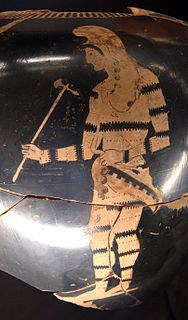 W
WThe sagaris is an ancient Iranian shafted weapon used by the horse-riding ancient Saka and Scythian peoples of the great Eurasian steppe. It was used also by Western and Central Asian peoples: the Medes, Persians, Parthians, Indo-Saka, Kushans, Mossynoeci, and others living within the milieu of Iranian peoples. According to Aristarchus of Samothrace, the legendary Amazons used the sagaris, as well. In The Histories, Herodotus attributes the sagaris to the Sacae Scythians in the army-list of Xerxes the Great.
 W
WA sledgehammer is a tool with a large, flat, often metal head, attached to a long handle. The long handle combined with a heavy head allows the sledgehammer to gather momentum during a swing and apply a large force compared to hammers designed to drive nails. Along with the mallet, it shares the ability to distribute force over a wide area. This is in contrast to other types of hammers, which concentrate force in a relatively small area.
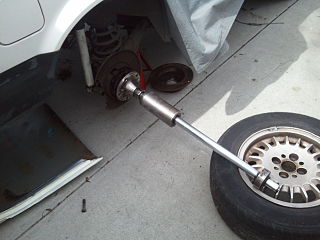 W
WA slide hammer is a tool that attaches to an object needing to be pulled and transmits an impact force to the object without striking the object itself.
 W
WA soft-faced hammer or mallet is a hammer designed to offer driving force without damaging surfaces. They also reduce the force transmitted back to the arm or hand of the user, by temporarily deforming more than a metal hammer would.
 W
WA splitting maul also known as a block buster, block splitter, chop and maul, sledge axe, go-devil or hamaxe is a heavy, long-handled axe used for splitting a piece of wood along its grain. One side of its head is like a sledgehammer, and the other side is like an axe.
 W
WA steam hammer, also called a drop hammer, is an industrial power hammer driven by steam that is used for tasks such as shaping forgings and driving piles. Typically the hammer is attached to a piston that slides within a fixed cylinder, but in some designs the hammer is attached to a cylinder that slides along a fixed piston.
 W
WA Stonemason's hammer, also known as a brick hammer, has one flat traditional face and a short or long chisel-shaped blade. It can thus be used to chip off edges or small pieces of stone, cut brick or a concrete masonry unit, without using a separate chisel. The chisel blade can also be used to rapidly cut bricks or cinder blocks. This type of hammer is also used by geologists when collecting rock and mineral samples and is one of several types of geologist's hammer.
 W
WA toffee hammer is a very small hammer designed for breaking up sheets or slabs of hard toffee, such as bonfire toffee, into small pieces suitable for consumption. A toffee hammer is sometimes included as a novelty item in gift packs produced by toffee manufacturers.
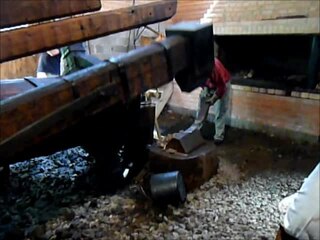 W
WA trip hammer, also known as a tilt hammer or helve hammer, is a massive powered hammer. Traditional uses of trip hammers include pounding, decorticating and polishing of grain in agriculture. In mining, trip hammers were used for crushing metal ores into small pieces, although a stamp mill was more usual for this. In finery forges they were used for drawing out blooms made from wrought iron into more workable bar iron. They were also used for fabricating various articles of wrought iron, latten, steel and other metals.
 W
WAn upholstery hammer is a lightweight hammer used for securing upholstery fabric to furniture frames using tacks or small nails.
 W
WA Warrington hammer is a type of cross-peen hammer commonly used in woodworking. Other names for the Warrington hammer include joiners' hammer, English pattern hammer, and Warrington pattern hammer.